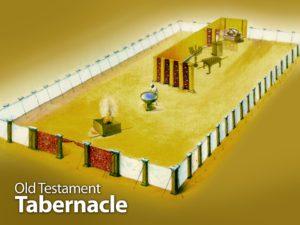 Lucas Osiander (1534-1604): The structure, which is called the holy of holies, was denoting Christ, who is the most holy temple of the Trinity, John 2, in whom all the fullness of deity dwells bodily, Colossians 2. The golden censor was designating the most efficacious prayers of Christ for the salvation of the church. The ark of the covenant, having been made of wood and having been covered with a layer of gold, was denoting Christ as human and God in one person. The manna is Christ, the bread of heaven, John 6. The rod of Aaron, which flowered (Num 17), was prefiguring the kingdom of Jesus Christ, our priest and king, which sometimes seems to dry up, but soon again blossoms unexpectedly. The tablets of the testament or Decalogue in the ark were signifying that in Christ we have the perfect fulfillment of the law, which is imputed for righteousness to all who believe in Christ, Romans 5. The two cherubim above the mercy seat, mutually looking at each other and averting their faces from the mercy seat, were designating the two testaments, the old and the new, which are mutually interpreted by each other. For the old, insofar as it represents Christ in the priesthood, points to the new by means of figures: truly the figures of the old testament become clear in the new. And the two testaments look to the one mediator Christ, who is the propitiation, not only for our sins, but even for the whole world, John 2. The cherubim that were covering the mercy seat and the ark were denoting that the ministry of the gospel is under the protection of the angels. Epistle to the Hebrews 9:3-5
Lucas Osiander (1534-1604): The structure, which is called the holy of holies, was denoting Christ, who is the most holy temple of the Trinity, John 2, in whom all the fullness of deity dwells bodily, Colossians 2. The golden censor was designating the most efficacious prayers of Christ for the salvation of the church. The ark of the covenant, having been made of wood and having been covered with a layer of gold, was denoting Christ as human and God in one person. The manna is Christ, the bread of heaven, John 6. The rod of Aaron, which flowered (Num 17), was prefiguring the kingdom of Jesus Christ, our priest and king, which sometimes seems to dry up, but soon again blossoms unexpectedly. The tablets of the testament or Decalogue in the ark were signifying that in Christ we have the perfect fulfillment of the law, which is imputed for righteousness to all who believe in Christ, Romans 5. The two cherubim above the mercy seat, mutually looking at each other and averting their faces from the mercy seat, were designating the two testaments, the old and the new, which are mutually interpreted by each other. For the old, insofar as it represents Christ in the priesthood, points to the new by means of figures: truly the figures of the old testament become clear in the new. And the two testaments look to the one mediator Christ, who is the propitiation, not only for our sins, but even for the whole world, John 2. The cherubim that were covering the mercy seat and the ark were denoting that the ministry of the gospel is under the protection of the angels. Epistle to the Hebrews 9:3-5
Ronald K. Rittgers (editor) Reformation Commentary on Scripture: New Testament XIII; Hebrews, James IVP Academic; 119
